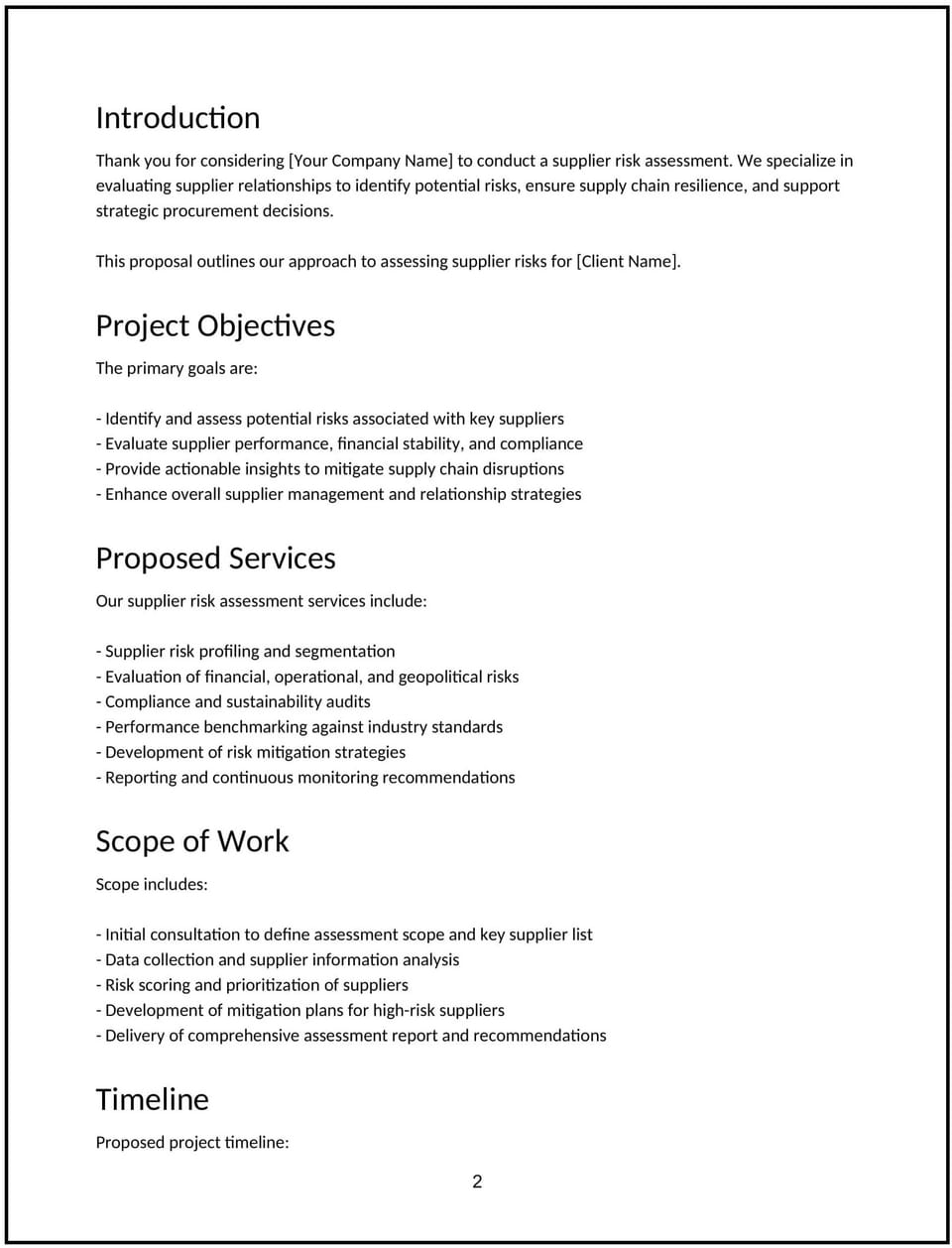Supplier risk assessment proposal: Free template

Customize this free supplier risk assessment proposal with Cobrief
Open this free supplier risk assessment proposal in Cobrief and start editing it instantly using AI. You can adjust the tone, structure, and content based on your client’s supplier base, industry risks, and operational goals. You can also use AI to review your draft — spot gaps, tighten language, and improve clarity before sending.
Once you're done, send, download, or save the proposal in one click — no formatting or setup required.
This template is fully customizable and built for real-world use — ideal for identifying supply chain vulnerabilities, evaluating vendor stability, and helping businesses mitigate operational, financial, or compliance risk. Whether you’re working with manufacturers, distributors, or service providers, this version gives you a structured head start and removes the guesswork.
What is a supplier risk assessment proposal?
A supplier risk assessment proposal outlines how you plan to evaluate and reduce risks posed by third-party suppliers. It typically includes a review of supplier reliability, financial health, geopolitical exposure, compliance practices, ESG factors, and operational resilience.
This type of proposal is used by procurement consultants, supply chain analysts, ESG advisors, and internal compliance teams — especially when onboarding new vendors, responding to disruptions, or strengthening supply chain governance.
Use this proposal to:
- Recommend a structured supplier scoring model or audit framework.
- Identify key risk indicators (KRIs) across multiple risk domains.
- Offer remediation or improvement plans for critical suppliers.
- Help clients prepare for investor, regulatory, or internal risk reporting.
This proposal supports better supplier decisions by making risk measurable, visible, and actionable.
Why use Cobrief to edit your proposal
Instead of copying a static template, you can use Cobrief to tailor and refine your proposal directly in your browser — with AI built in to help along the way.
- Edit the proposal directly in your browser: No setup or formatting required — just click and start customizing.
- Rewrite sections with AI: Highlight any sentence and choose from actions like shorten, expand, simplify, or change tone.
- Run a one-click AI review: Get instant suggestions to improve clarity, fix vague sections, or tighten your message.
- Apply AI suggestions instantly: Review and accept individual AI suggestions, or apply all improvements across the proposal in one click.
- Share or export instantly: Send your proposal through Cobrief or download a clean PDF or DOCX version when you’re done.
Cobrief helps you create a polished, persuasive proposal — without wasting time on formatting or second-guessing your copy.
When to use this proposal
This supplier risk assessment proposal works well in scenarios like:
- When onboarding new suppliers for critical components or services.
- When a key vendor is showing signs of financial or operational distress.
- When conducting annual risk reviews for compliance or audit purposes.
- When preparing for ISO certification, ESG disclosures, or investor due diligence.
- When responding to recent supply chain disruptions or incidents.
Use this proposal whenever you need to surface, evaluate, and reduce vendor-related risks in a structured, repeatable way.
What to include in a supplier risk assessment proposal
Each section of the proposal is designed to help you explain your offer clearly and professionally. Here's how to use them:
- Executive summary: Position the assessment as a tool for improving supply chain resilience, avoiding surprises, and meeting internal or external risk standards.
- Scope of work: Include supplier mapping, data gathering, risk scoring framework, individual supplier assessments, portfolio risk analysis, reporting dashboard, and recommended actions.
- Timeline: Break into phases — planning, data collection, assessment, reporting, and follow-up. Projects typically span 2–6 weeks depending on supplier count.
- Pricing: Offer fixed-fee or tiered pricing based on supplier volume or risk categories. Include optional services like on-site audits, regulatory mapping, or ESG risk scoring.
- Terms and conditions: Clarify access to supplier data, confidentiality protocols, reporting obligations, and usage rights for scoring models.
- Next steps: Include a CTA like “Approve to begin supplier list review and scoring framework setup” or “Schedule kickoff to align on risk domains and thresholds.”
How to write an effective supplier risk assessment proposal
Use these best practices to show credibility, control, and value:
- Make the client the focus: Show how the assessment protects margins, brand, and continuity — not just flags risk for its own sake.
- Personalize where it matters: Reference their supplier footprint, compliance requirements, or recent issues (e.g., delivery delays, audit failures).
- Show results, not just frameworks: Use examples like “Reduced average supplier risk score by 35% over six months” or “Flagged 12% of vendors with missing compliance data.”
- Be clear and confident: Translate technical or compliance-heavy language into business impact.
- Keep it skimmable: Use clear headings, bullet points, and risk categories to help busy ops or procurement leaders scan quickly.
- End with momentum: Suggest a lightweight pilot (e.g., assess top 10 vendors) to prove value quickly.
Frequently asked questions (FAQs)
What types of supplier risks does this cover?
This can include financial stability, legal/compliance exposure, delivery reliability, geographic or political risk, data security, and ESG or reputational risk.
Can I customize the risk scoring model for each client?
Yes — you can adjust weightings, thresholds, or categories depending on the client’s industry and priorities.
Is this proposal suitable for international suppliers?
Absolutely. Just include relevant geopolitical, trade, or regulatory factors when scoring non-domestic vendors.
What data do I need to get started?
Typically a supplier list with names, regions, contact points, categories, and any available performance or compliance data.
Can I reuse this proposal for multiple clients or audits?
Yes — just update the supplier context and any client-specific risk categories or goals.
This article contains general legal information and does not contain legal advice. Cobrief is not a law firm or a substitute for an attorney or law firm. The law is complex and changes often. For legal advice, please ask a lawyer.